Concentration of Polyphenolic Antioxidants in Apple Juice and Extract Using Ultrafiltration
Abstract
1. Introduction
2. Materials and Methods
2.1. Materials
2.1.1. Chemicals
2.1.2. Plant Materials
Apple Extract
Apple Juice from Concentrate
2.2. Methods
2.2.1. Membrane Equipment
2.2.2. Calculation of Main Characteristics of Ultrafiltration Process
2.2.3. Sample Preparation
Sample Preparation for Spectrophotometric Analyses
Sample Preparation for HPLC–DAD (High-Performance Liquid Chromatography with Diode-Array Detection) Analysis
2.2.4. Spectrophotometric Analyses
Determination of Total Polyphenols
Determination of Total Antioxidant Capacity
- DPPH Test
- FRAP Test
2.2.5. HPLC–DAD Analysis
2.2.6. Determination of Total Water-Soluble Proteins
2.2.7. Statistical Analysis
3. Results and Discussion
3.1. Permeate Flux
3.2. Total Polyphenolics
3.2.1. Total Polyphenolic Content
3.2.2. Concentration of Total Polyphenolics
3.2.3. Rejection of Total Polyphenolics
3.3. Water-Soluble Proteins in Retentates Obtained via Ultrafiltration of Apple Juice
3.4. HPLC Separation of Polyphenols
3.5. Phenolic Acids
3.6. Ferric-Reducing Antioxidant Power (FRAP)
3.6.1. Changes in the Ferric-Reducing Antioxidant Power during Ultrafiltration of Apple Extract and Juice
3.6.2. Concentration Factor of the Ferric-Reducing Antioxidant Power
3.6.3. Rejection of Ferric-Reducing Antioxidant Power
3.7. Free Radical-Scavenging Ability (DPPH)
3.7.1. Changes in Free Radical-Scavenging Ability
3.7.2. Concentration of the Antioxidants with Radical-Scavenging Ability
3.7.3. Rejection of the Antioxidants with Radical-Scavenging Ability
4. Conclusions
Author Contributions
Funding
Institutional Review Board Statement
Informed Consent Statement
Data Availability Statement
Acknowledgments
Conflicts of Interest
References
- Aaby, K.; Skrede, G.; Wrolstad, R.E. Phenolic composition and antioxidant activities in flesh and achenes of strawberries (Fragaria ananassa). J. Agric. Food Chem. 2005, 53, 4032–4040. [Google Scholar] [CrossRef] [PubMed]
- Stübler, A.S.; Lesmes, U.; Juadjur, A.; Heinz, V.; Rauh, C.; Shpigelman, A.; Aganovic, K. Impact of pilot-scale processing (thermal, PEF, HPP) on the stability and bioaccessibility of polyphenols and proteins in mixed protein and polyphenol-rich juice systems. Innov. Food Sci. Emerg. Technol. 2020, 64, 102426. [Google Scholar] [CrossRef]
- Lamothe, S.; Guérette, C.; Dion, F.; Sabik, H.; Britten, M. Antioxidant activity of milk and polyphenol-rich beverages during simulated gastrointestinal digestion of linseed oil emulsions. Food Res. Int. 2019, 122, 149–156. [Google Scholar] [CrossRef] [PubMed]
- Gaglianò, M.; Conidi, C.; De Luca, G.; Cassano, A. Partial removal of sugar from apple juice by nanofiltration and discontinuous diafiltration. Membranes 2022, 12, 712. [Google Scholar] [CrossRef]
- Echavarría, A.P.; Falguera, V.; Torras, C.; Berdún, C.; Pagán, J.; Ibarz, A. Ultrafiltration and reverse osmosis for clarification and concentration of fruit juices at pilot plant scale. LWT Food Sci. Technol. 2012, 46, 189–195. [Google Scholar] [CrossRef]
- Gulec, H.A.; Bagci, P.O.; Bagci, U. Clarification of apple juice using polymeric ultrafiltration membranes: A comparative evaluation of membrane fouling and juice quality. Food Bioprocess Technol. 2017, 10, 875–885. [Google Scholar] [CrossRef]
- Cissé, M.; Vaillant, F.; Pallet, D.; Dornier, M. Selecting ultrafiltration and nanofiltration membranes to concentrate anthocyanins from roselle extract (Hibiscus sabdariffa L.). Food Res. Int. 2011, 44, 2607–2614. [Google Scholar] [CrossRef]
- Tylkowski, B.; Tsibranska, I.; Kochanov, R.; Peev, G.; Giamberini, M. Concentration of biologically active compounds extracted from Sideritis ssp. L. by nanofiltration. Food Bioprod. Process. 2011, 89, 309–314. [Google Scholar] [CrossRef]
- Mondal, M.; Biswas, P.P.; De, S. Clarification and storage study of bottle gourd (Lagenaria siceraria) juice by hollow fiber ultrafiltration. Food Bioprod. Process. 2016, 100, 1–15. [Google Scholar] [CrossRef]
- Jahadi, M.; Ehsani, M.; Paidari, S. Characterization of milk proteins in ultrafiltration permeate and their rejection coefficients. J. Food Biosci. Technol. 2018, 8, 49–54. [Google Scholar]
- Montenegro-Landívar, M.F.; Tapia-Quirós, P.; Vecino, X.; Reig, M.; Granados, M.; Farran, A.; Cortina, J.L.; Saurina, J.; Valderrama, C. Recovery of natural polyphenols from spinach and orange by-products by pressure-driven membrane processes. Membranes 2022, 12, 669. [Google Scholar] [CrossRef] [PubMed]
- Kumar, P.; Sharma, N.; Ranjan, R.; Kumar, S.; Bhat, Z.F.; Jeong, D.K. Perspective of membrane technology in dairy industry: A review. J. Anim. Sci. 2013, 26, 1347–1358. [Google Scholar] [CrossRef] [PubMed]
- Baldasso, C.; Barros, T.; Tessaro, I. Concentration and purification of whey proteins by ultrafiltration. Desalination 2011, 278, 381–386. [Google Scholar] [CrossRef]
- Macedo, A.; Pinho, M.; Duarte, E. Application of ultrafiltration for valorization of ovine cheese whey. Procedia Eng. 2012, 44, 1949–1950. [Google Scholar] [CrossRef][Green Version]
- Ong, L.; Dagastine, R.; Kentish, S.; Gras, S. Microstructure and composition of full fat cheddar cheese made with ultrafiltered milk retentate. Foods 2013, 2, 310–331. [Google Scholar] [CrossRef] [PubMed]
- Domagala, J.; Wszolek, M. Effect of concentration method and starter culture type on the texture and susceptibility to syneresis of yoghurt and bio-yoghurts made of goat’s milk. Zywnosc. Nauka. Technol. Jakosc. 2008, 15, 118–126. [Google Scholar]
- Domagala, J.; Wszolek, M.; Dudzinska, A. The influence of the fortification method and starter culture type on the texture and microstructure of probiotic yoghurts prepared from goat’s milk. Milchwissenschaft 2012, 67, 172–176. [Google Scholar]
- Mehaia, M.A. Manufacture of fresh labenh from goats’ milk using ultrafiltration process. J. Food Technol. 2005, 3, 24–29. [Google Scholar]
- Mohammad, A.W.; Ng, C.Y.; Lim, Y.P.; Ng, G.H. Ultrafiltration in food processing industry: Review on application, membrane fouling, and fouling control. Food Bioprocess Technol. 2012, 5, 1143–1156. [Google Scholar] [CrossRef]
- Urošević, T.; Povrenović, D.; Vukosavljević, P.; Urošević, I.; Stevanović, S. Recent developments in microfiltration and ultrafiltration of fruit juices. Food Bioprod. Process. 2017, 106, 147–161. [Google Scholar] [CrossRef]
- Conidi, C.; Cassano, A.; Caiazzo, F.; Drioli, E. Separation and purification of phenolic compounds from pomegranate juice by ultrafiltration and nanofiltration membranes. J. Food Eng. 2017, 195, 1–13. [Google Scholar] [CrossRef]
- Matta, V.M.; Moretti, R.H.; Cabral, L.M.C. Microfiltration and reverse osmosis for clarification and concentration of acerola juice. J. Food Eng. 2004, 61, 477–482. [Google Scholar] [CrossRef]
- Singleton, V.L.; Rossi, J.A. Colorimetry of total phenolics with phosphomolybdic-phosphotungstic acid reagents. Am. J. Enol. Viticult. 1965, 16, 144–158. [Google Scholar]
- Brand-Williams, W.; Cuvelier, M.E.; Berset, C. Use of a free radical method to evaluate antioxidant activity. LWT Food Sci. Technol. 1995, 28, 25–30. [Google Scholar] [CrossRef]
- Benzie, I.F.F.; Strain, J.J. The ferric reducing ability of plasma (FRAP) as a measure of “antioxidant power”: The FRAP assay. Anal. Biochem. 1996, 239, 70–76. [Google Scholar] [CrossRef]
- Schieber, A.; Keller, P.; Carle, R. Determination of phenolic acids and flavonoids of apple and pear by high-performance liquid chromatography. J. Chromatogr. A 2001, 910, 265–273. [Google Scholar] [CrossRef]
- Bradford, M.M. A rapid and sensitive method for the quantitation of microgram quantities of protein utilizing the principle of protein-dye binding. Anal. Biochem. 1976, 72, 248–254. [Google Scholar] [CrossRef]
- Wei, D.S.; Hossain, M.; Saleh, Z.S. Separation of polyphenolics and sugar by ultrafiltration: Effects of operating conditions on fouling and diafiltration. Int. J. Nat. Sci. Eng. 2008, 1, 10–17. [Google Scholar]
- Cai, M.; Xie, C.; Lv, Y.; Yang, K.; Sun, P. Changes in physicochemical profiles and quality of apple juice treated by ultrafiltration and during its storage. Food Sci. Nutr. 2020, 8, 2913–2919. [Google Scholar] [CrossRef]
- Dawale, S.A.; Jawade, N.R. Using nanofiltration and ultrafiltration for the concentration of Amla (Phyllanthus Emblica) juice. Int. J. Interact. Des. Manuf. Technol. 2014, 8, 15–20. [Google Scholar]
- Huang, W.; Wang, B.; Cheng, N.; Gao, H.; Cao, W. Effects of molecular weight cut-off (MWCO) on jujube juice quality during ultrafiltration. Acta Hortic. 2013, 993, 225–230. [Google Scholar] [CrossRef]
- Qaid, S.; Zait, M.; EL Kacemi, K.; ELMidaoui, A.; EL Hajji, H.; Taky, M. Ultrafiltration for clarification of valencia orange juice: Comparison of two flat sheet membranes on quality of juice production. J. Mater. Environ. Sci. 2017, 8, 1186–1194. [Google Scholar]
- Peters, C.D.; Rantissi, T.; Gitis, V.; Hankins, N.P. Retention of natural organic matter by ultrafiltration and the mitigation of membrane fouling through pre-treatment, membrane enhancement, and cleaning—A review. J. Water Process Eng. 2021, 44, 102374. [Google Scholar] [CrossRef]
- Hsu, J.C.; Heautherbell, D.A.; Yorgey, B.M. Effect of fruit storage and processing on clarity, proteins and stability of granny smith apple juice. J. Food Sci. 1989, 54, 660–662. [Google Scholar] [CrossRef]
- Wu, L.-C.; Siebert, K.J. Characterization of haze-active proteins in apple juice. J. Agric. Food Chem. 2002, 50, 3828–3834. [Google Scholar] [CrossRef] [PubMed]
- Mihalev, K.; Schieber, A.; Mollov, P.; Carle, R. Effect of mash maceration on the polyphenolic content and visual quality attributes of cloudy apple juice. J. Agric. Food Chem. 2004, 52, 7306–7310. [Google Scholar] [CrossRef]
- Conidi, C.; Destani, F.; Cassano, A. Performance of hollow fiber ultrafiltration membranes in the clarification of blood orange juice. Beverages 2015, 1, 341–353. [Google Scholar] [CrossRef]
- Acosta, O.; Vaillant, F.; Pérez, A.M.; Dornier, M. Potential of ultrafiltration for separation and purification of ellagitannins in blackberry (Rubus adenotrichus Schltdl.) juice. Sep. Purif. Technol. 2014, 125, 120–125. [Google Scholar] [CrossRef]
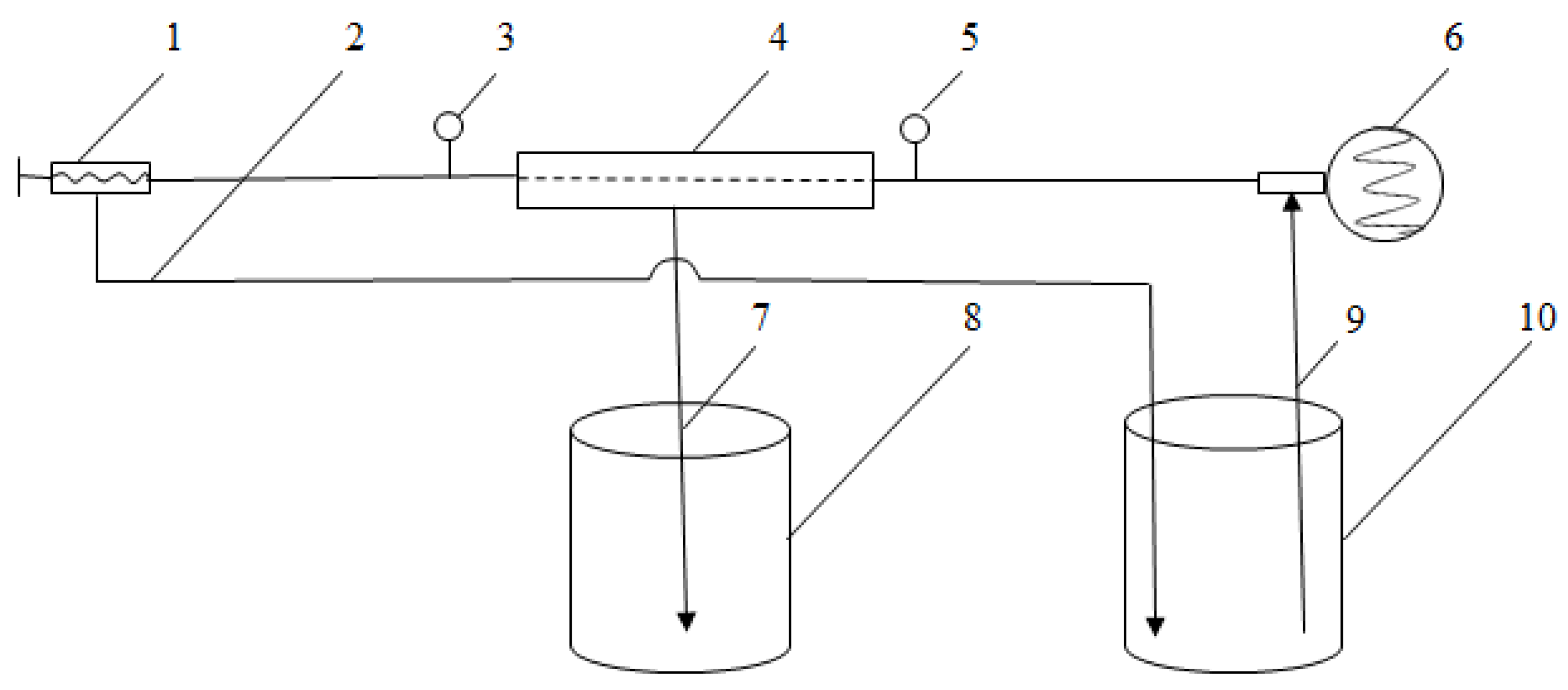
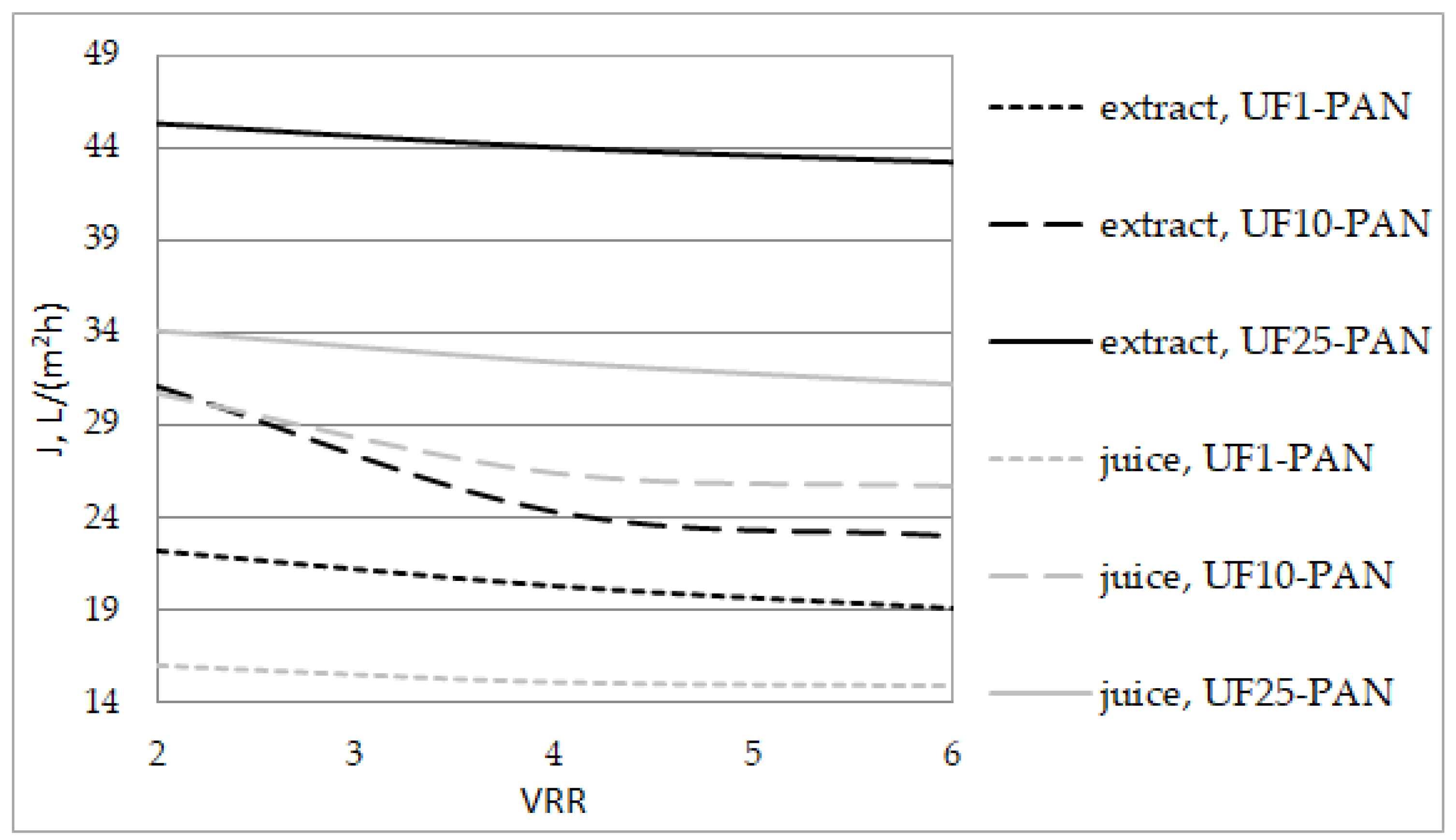
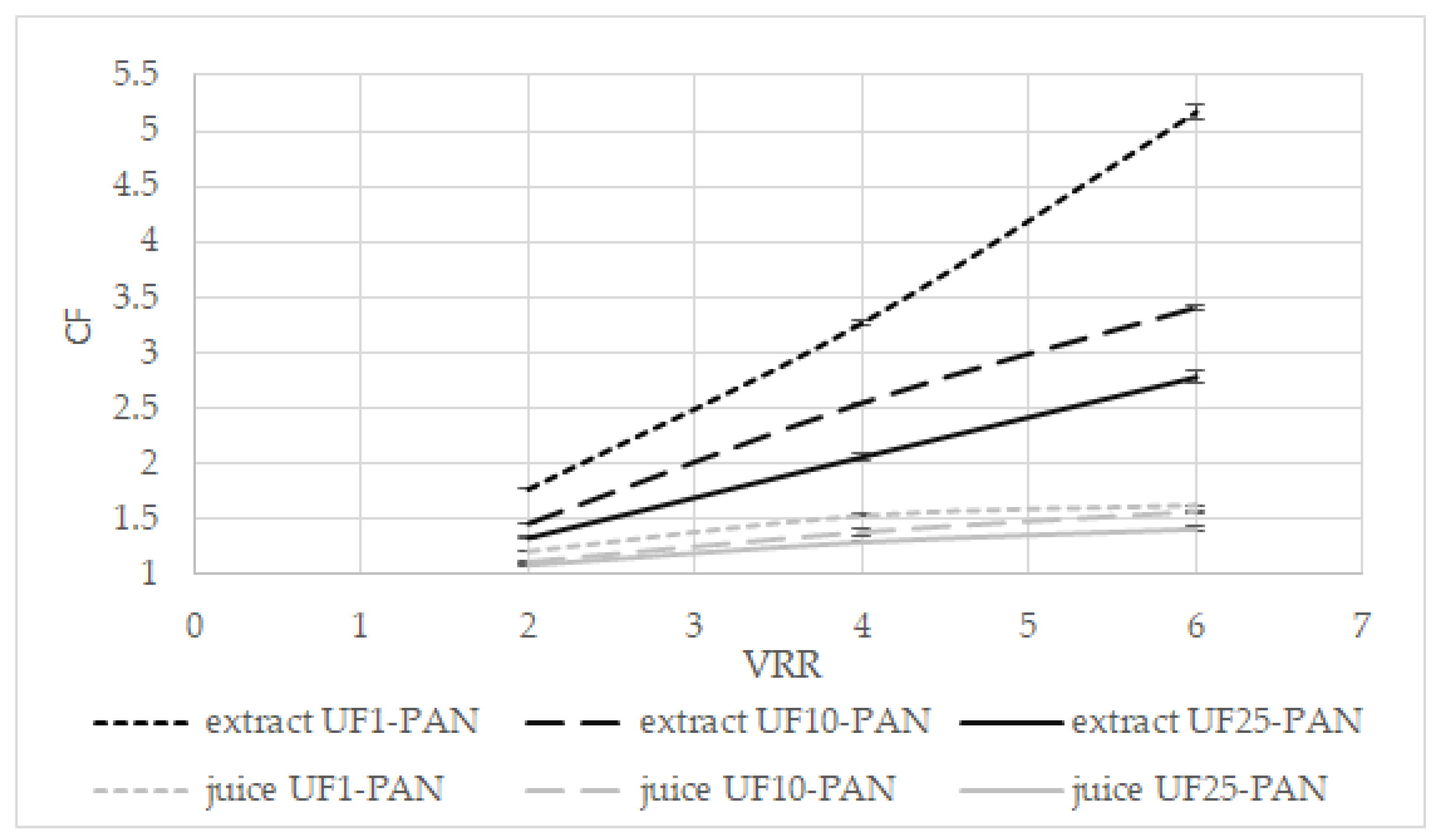
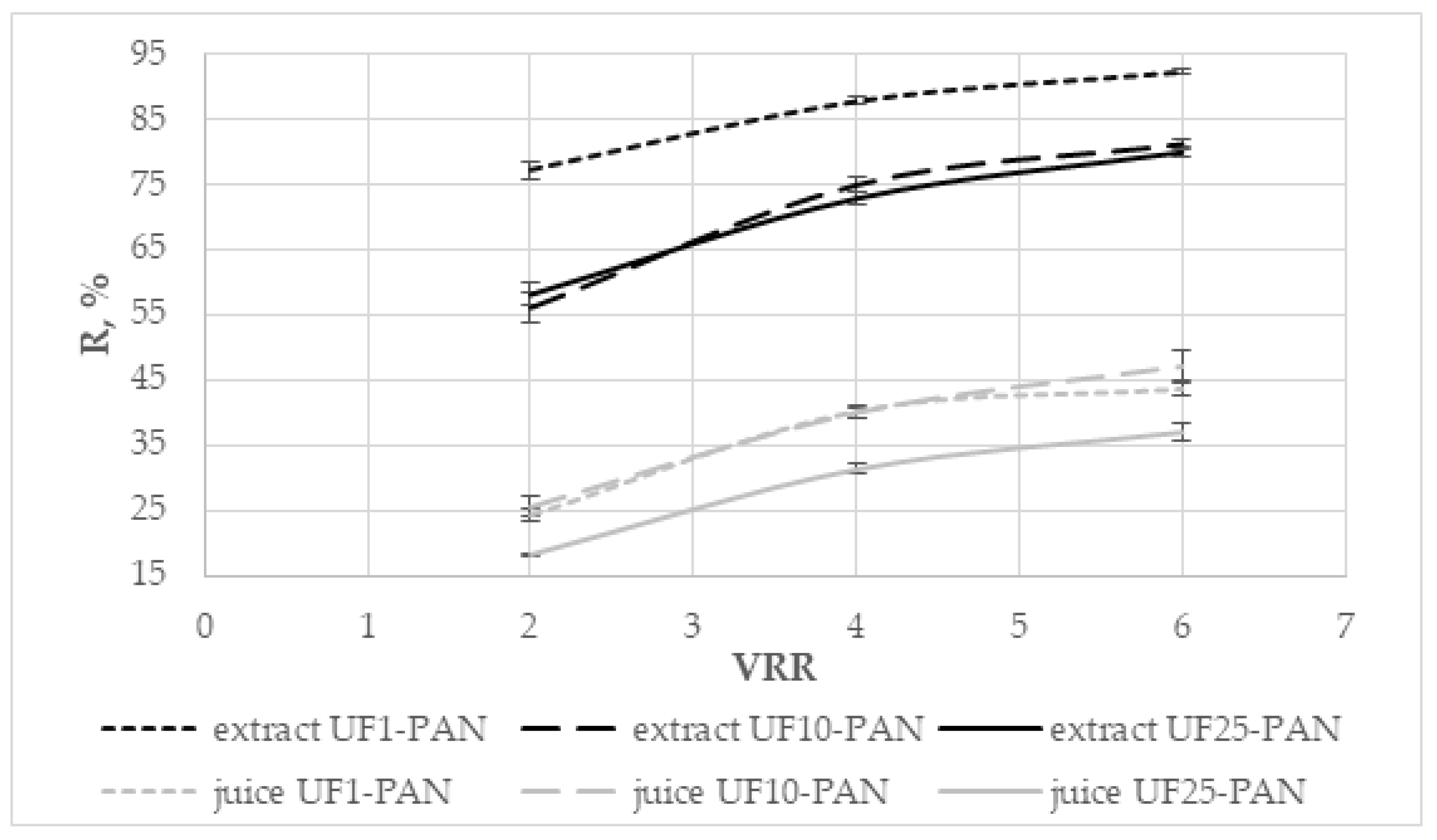
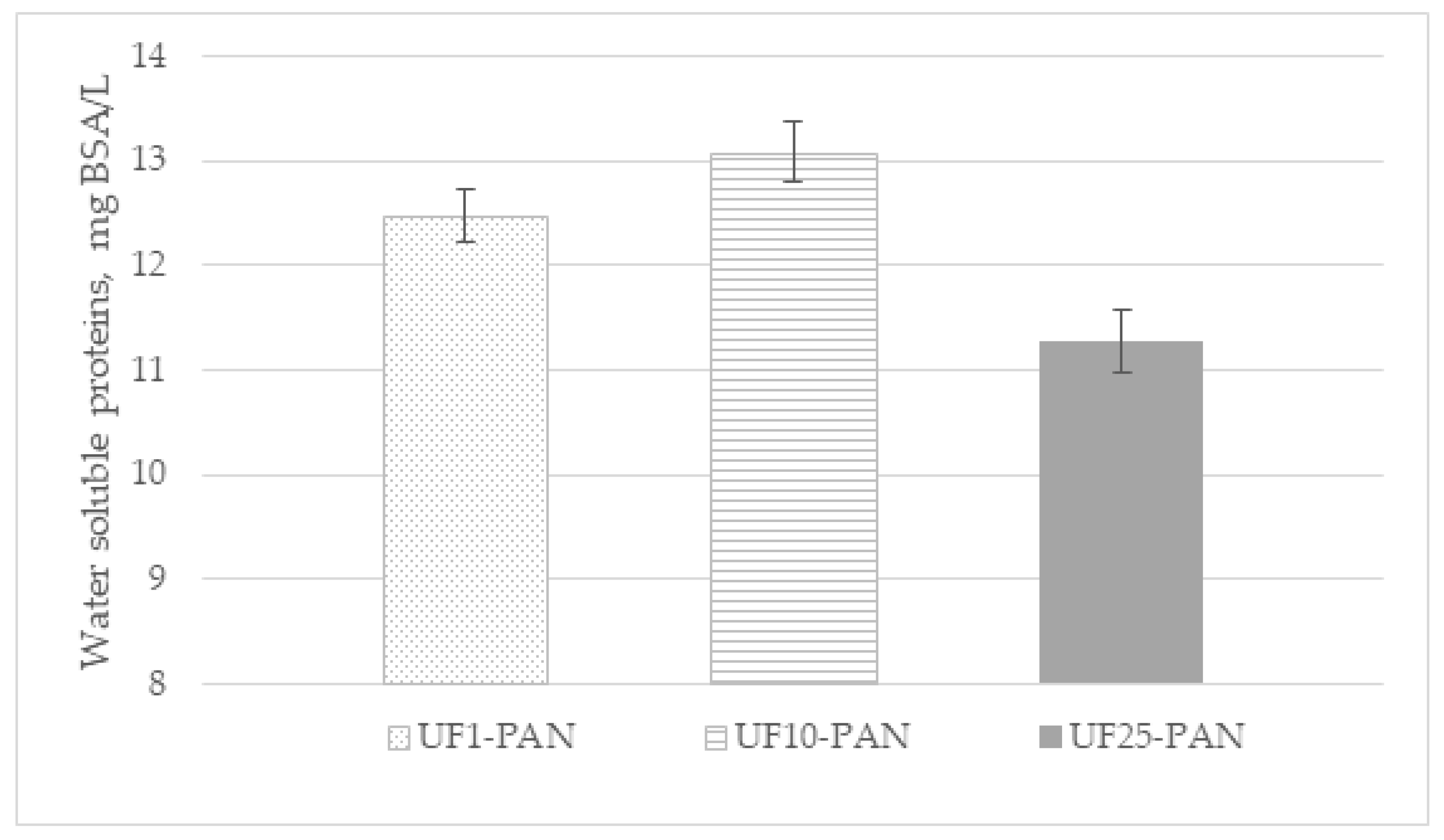
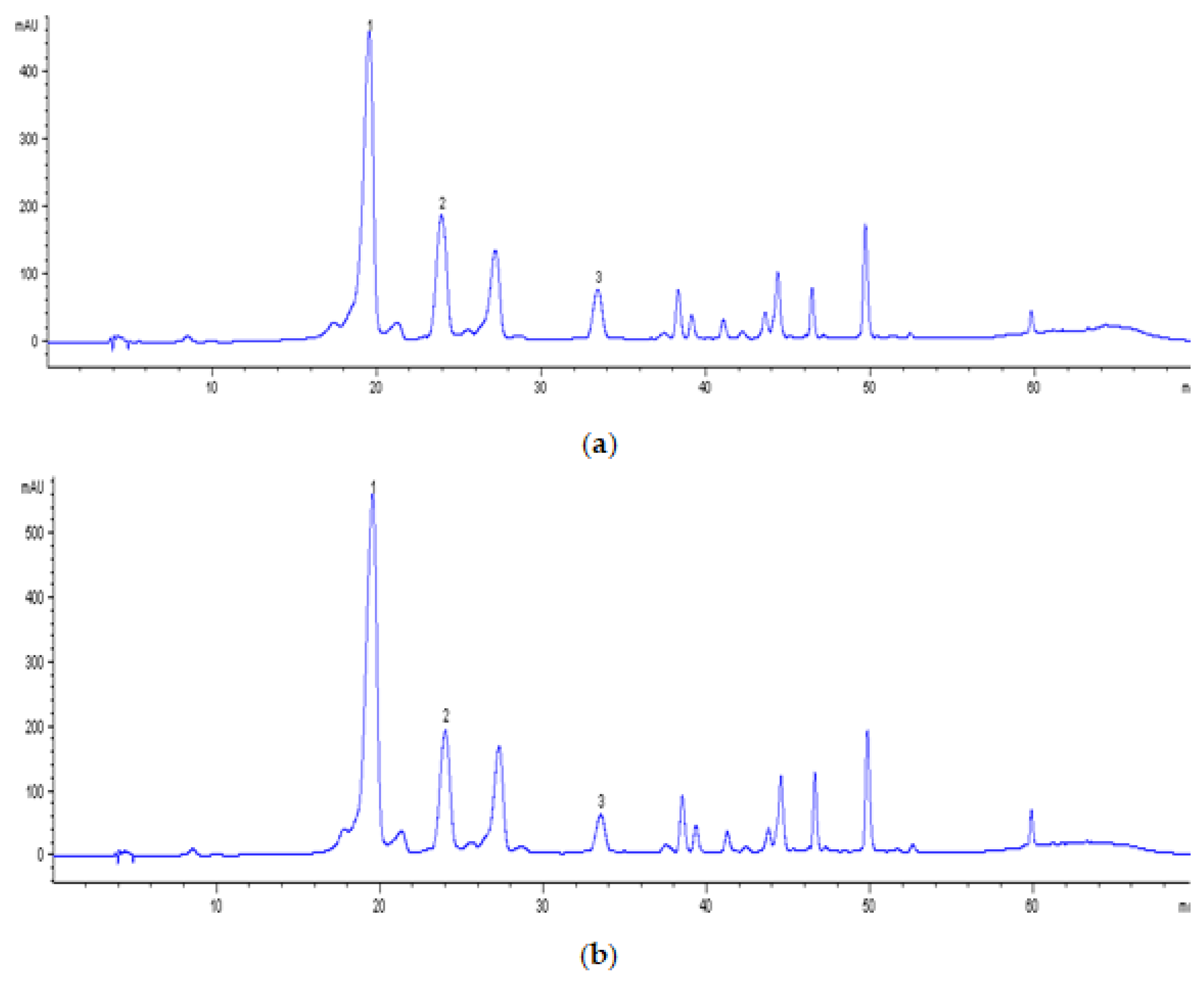
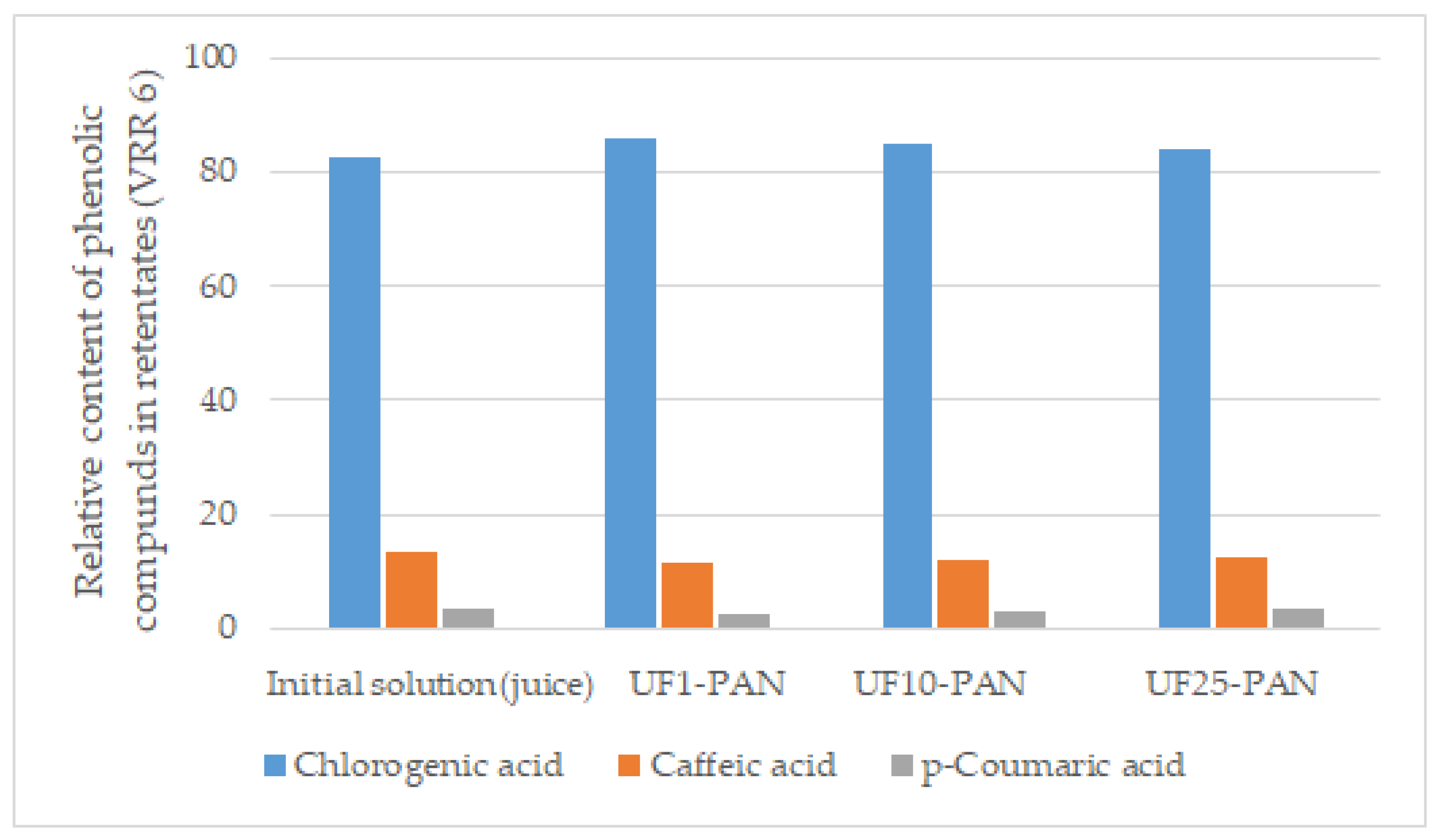
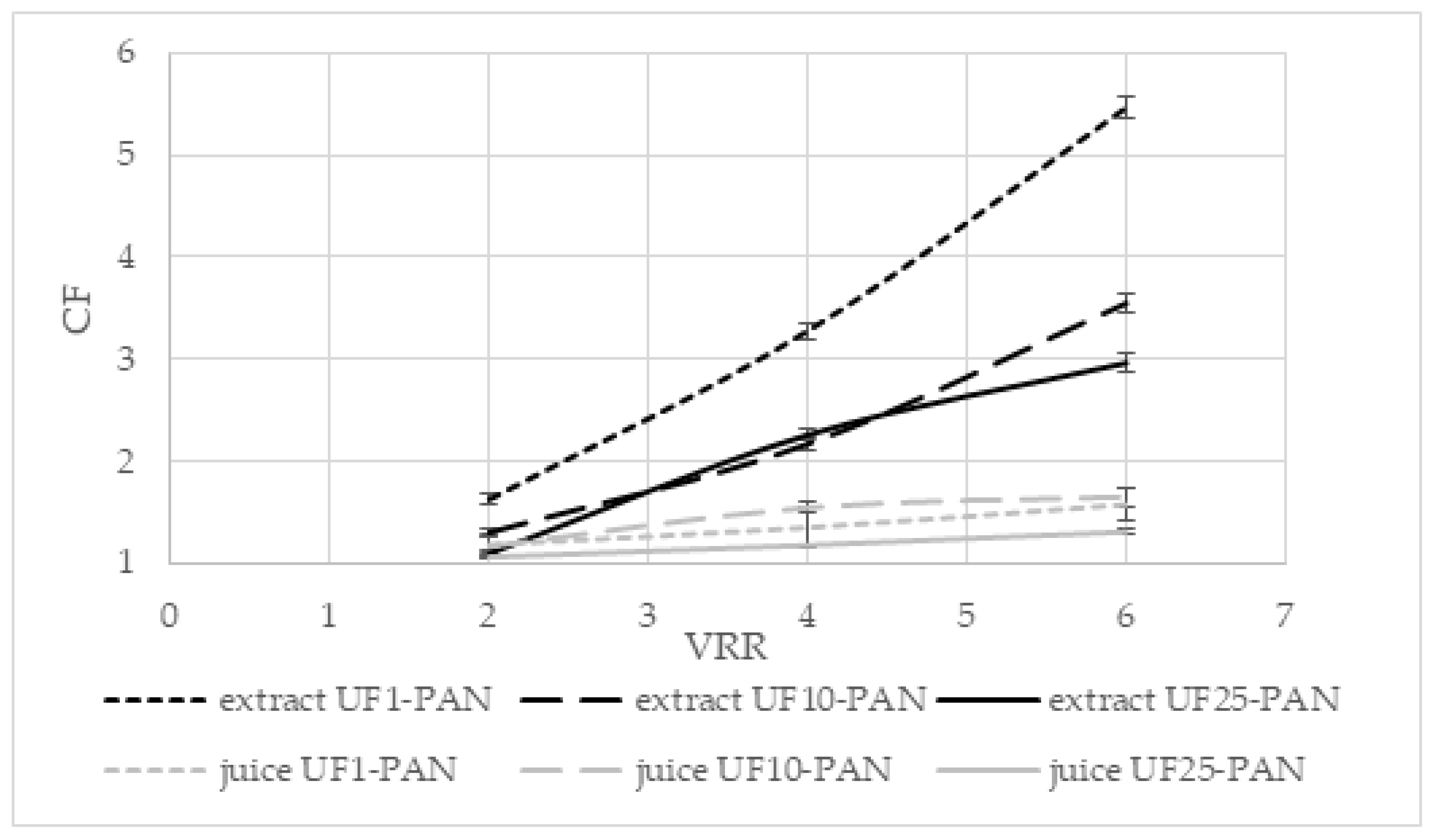
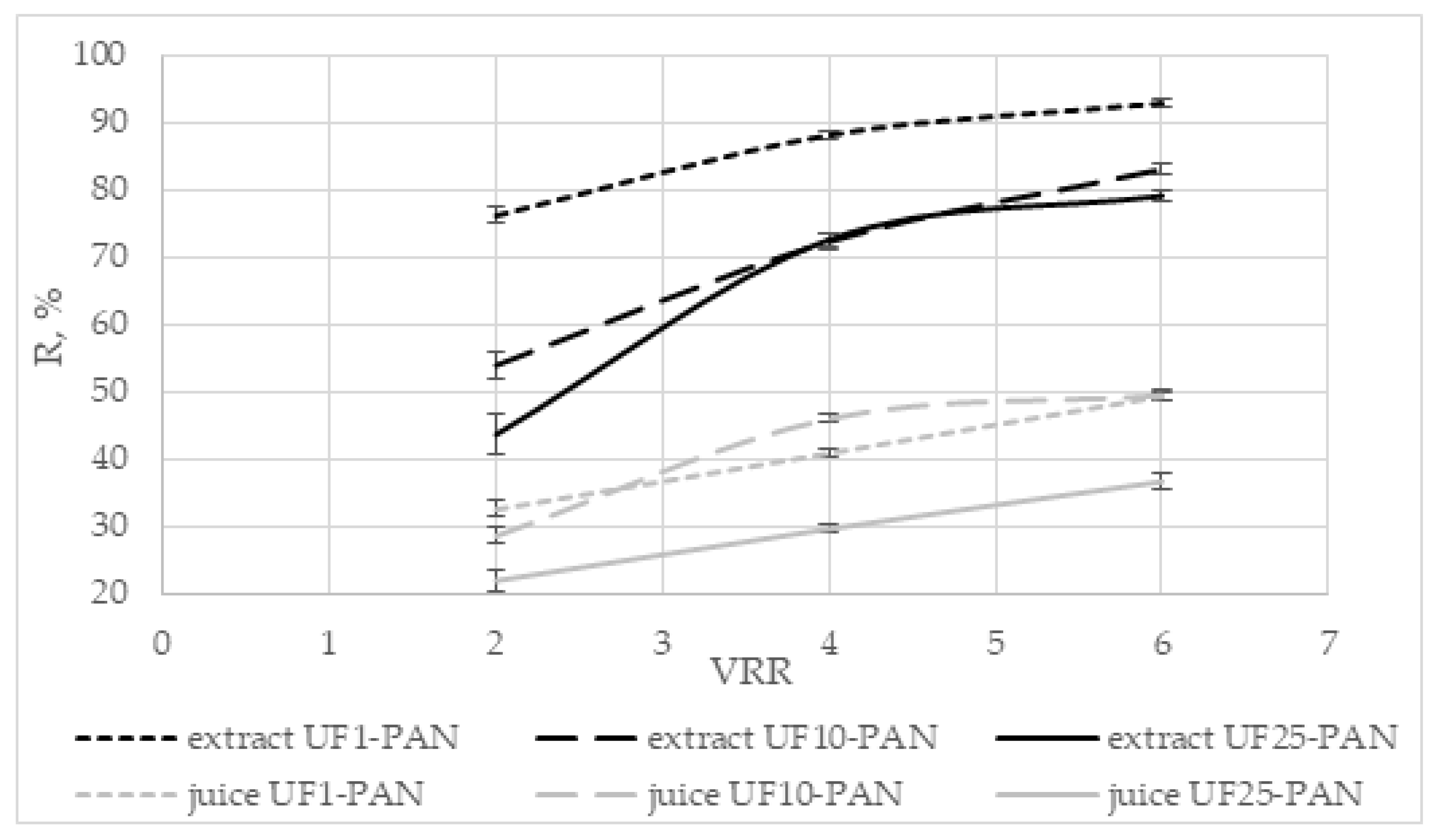

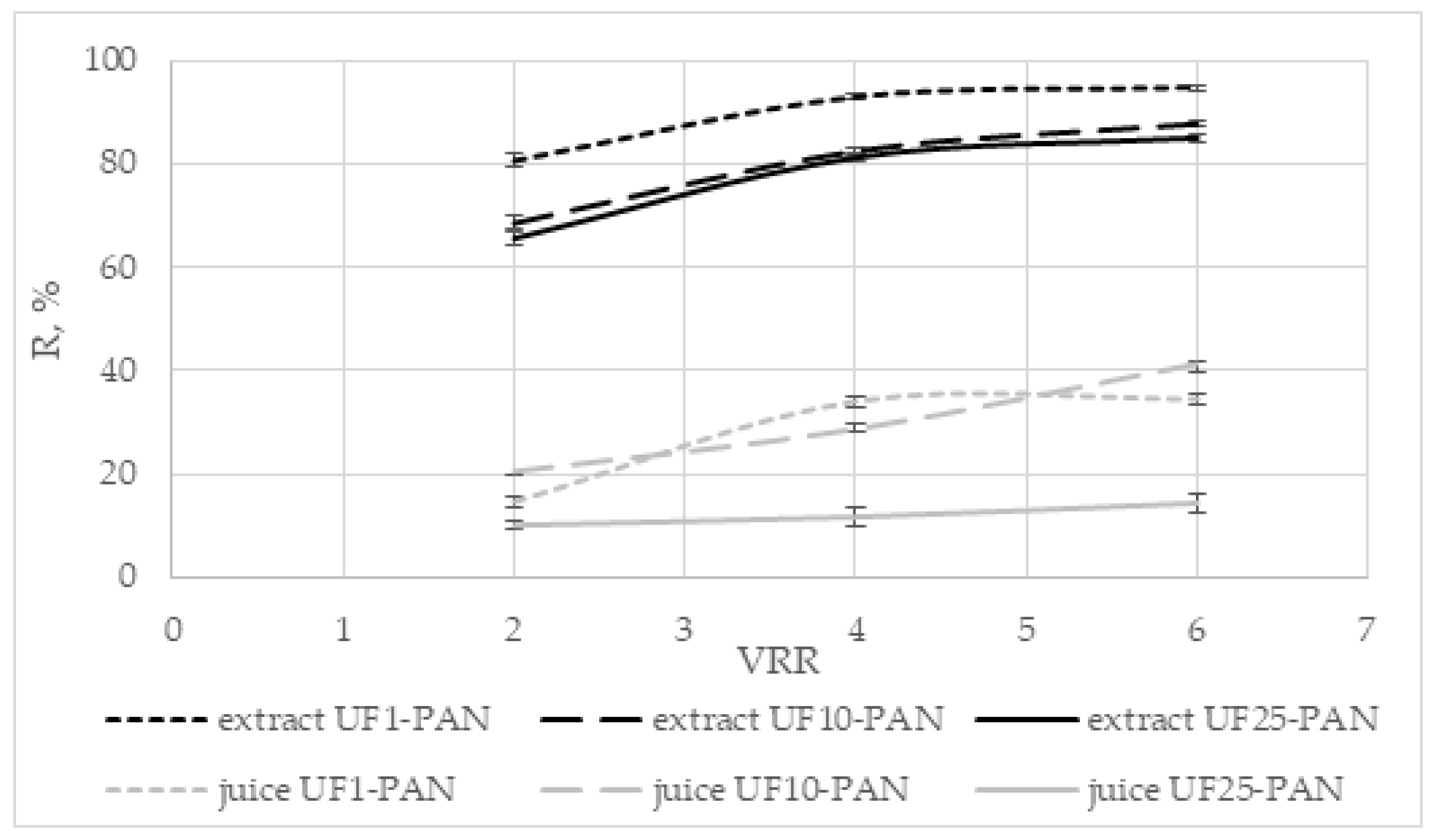
| Sample | Membranes | |||
|---|---|---|---|---|
| UF1-PAN | UF10-PAN | UF25-PAN | ||
| Feed solution | Extract | 65.9 ± 1.9 a,A | 64.6 ± 1.2 a,A | 68.6 ± 2.1 a,A |
| Juice | 51.8 ± 2.5 a,A | 60.8 ± 3 a,A | 58.2 ± 2.1 a,A | |
| Permeate | Extract | 26.6 ± 0.8 b,A | 41.5 ± 1.1 b,B | 38.4 ± 0.9 b,C |
| Juice | 47.5 ± 1.5 b,A | 50.5 ± 2 b,A | 51.7 ± 1.7 b,A | |
| Retentate at VRR 2 | Extract | 116.7 ± 3.2 c,A | 94.4 ± 2.1 c,B | 91.6 ± 1.8 c,B |
| Juice | 62.7 ± 3 c,A | 67.8 ± 2.9 a,A | 63.2 ± 2.1 c,A | |
| Retentate at VRR 4 | Extract | 215.9 ± 4.1 d,A | 165.0 ± 3.2 d,B | 141.1 ± 1.9 d,C |
| Juice | 79.4 ± 3.5 d,A | 84.1 ± 2.5 c,B | 75.2 ± 1.9 d,A | |
| Retentate at VRR 6 | Extract | 340.7 ± 5.0 e,A | 220.1 ± 2.8 e,B | 191.0 ± 2.4 e,C |
| Juice | 84.2 ± 4.1 d,A | 95.4 ± 3.9 d,B | 82.0 ± 4.5 d,A | |
| Name of the Compound | Feed Solution (Apple Juice) | Membranes | ||
|---|---|---|---|---|
| UF1-PAN | UF10-PAN | UF25-PAN | ||
| Chlorogenic acid | 35.67 ± 1.14 a | 44.35 ± 1.02 b | 43.60 ± 0.65 b,c | 41.53 ± 1.11 c |
| Caffeic acid | 5.78 ± 0.02 a | 6.00 ± 0.23 a | 6.21 ± 0.21 a | 6.26 ± 0.22 a |
| p-Coumaric acid | 1.61 ± 0.04 a | 1.28 ± 0.03 b | 1.61 ± 0.09 a | 1.72 ± 0.08 a |
| Sum of phenolic acids | 43.06 | 51.63 | 51.42 | 49.51 |
| Sample | Membranes | |||
|---|---|---|---|---|
| UF1-PAN | UF10-PAN | UF25-PAN | ||
| Feed solution | Extract | 267.6 ± 5.5 a,A | 279.4 ± 4.3 a,A | 275.3 ± 3.9 a,A |
| Juice | 163.5 ± 6 a,A | 163.5 ± 6 a,A | 180.7 ± 8.1 a,A | |
| Permeate | Extract | 104.0 ± 3.2 b,A | 168.1 ± 5.1 b,B | 170.5 ± 4.5 b,B |
| Juice | 131.0 ± 4 b,A | 136.9 ± 3.7 b,A | 150.2 ± 6.2 b,A | |
| Retentate at VRR 2 | Extract | 436.3 ± 8.5 c,A | 364.8 ± 4.1 c,B | 302.5 ± 7.9 c,C |
| Juice | 194.0 ± 5.5 c,A | 195.1 ± 8.5 c,A | 192.3 ± 4.3 a,A | |
| Retentate at VRR 4 | Extract | 877.3 ± 10.2 d,A | 606.7 ± 8.9 d,B | 622.4 ± 7.3 d,B |
| Juice | 221.4 ± 7.2 d,A | 253.3 ± 5.9 d,B | 213.3 ± 8 d,C | |
| Retentate at VRR 6 | Extract | 1462.2 ± 12.8 e,A | 991.9 ± 11.0 e,B | 816.1 ± 13.1 e,C |
| Juice | 258.4 ± 8 e,A | 270.7 ± 7.2 d,A | 237.0 ± 5.3 e,B | |
| Sample | Membranes | |||
|---|---|---|---|---|
| UF1-PAN | UF10-PAN | UF25-PAN | ||
| Feed solution | Extract | 309.6 ± 10.5 a,A | 360.4 ± 9.2 a,B | 387.4 ± 8.1 a,C |
| Juice | 135.3 ± 4.3 a,A | 170.9 ± 5.2 a,B | 384.9 ± 10.8 a,C | |
| Permeate | Extract | 114.6 ± 4.5 b,A | 183.3 ± 5.2 b,B | 194.5 ± 5.0 b,B |
| Juice | 127.0 ± 3.8 b,A | 160.5 ± 5 b,B | 335.3 ± 5.8 b,C | |
| Retentate at VRR = 2 | Extract | 591.3 ± 12.4 c,A | 582.2 ± 10.1 c,A | 565.3 ± 11 c,A |
| Juice | 148.9 ± 4.4 c,A | 202.1 ± 5.3 c,B | 393.3 ± 10.0 a,C | |
| Retentate at VRR = 4 | Extract | 1627.6 ± 18.5 d,A | 1043.3 ± 20.4 d,B | 1035.3 ± 15.6 d,B |
| Juice | 192.8 ± 6.0 d,A | 225.3 ± 9.9 d,B | 400.5 ± 15.5 a,A | |
| Retentate at VRR = 6 | Extract | 2194.4 ± 35.1 e,A | 1491.7 ± 28.4 e,B | 1298.1 ± 32 e,C |
| Juice | 194.2 ± 4.1 d,A | 273.9 ± 17.9 e,B | 412.9 ± 15.0 a,C | |
Publisher’s Note: MDPI stays neutral with regard to jurisdictional claims in published maps and institutional affiliations. |
© 2022 by the authors. Licensee MDPI, Basel, Switzerland. This article is an open access article distributed under the terms and conditions of the Creative Commons Attribution (CC BY) license (https://creativecommons.org/licenses/by/4.0/).
Share and Cite
Dushkova, M.; Mihalev, K.; Dinchev, A.; Vasilev, K.; Georgiev, D.; Terziyska, M. Concentration of Polyphenolic Antioxidants in Apple Juice and Extract Using Ultrafiltration. Membranes 2022, 12, 1032. https://doi.org/10.3390/membranes12111032
Dushkova M, Mihalev K, Dinchev A, Vasilev K, Georgiev D, Terziyska M. Concentration of Polyphenolic Antioxidants in Apple Juice and Extract Using Ultrafiltration. Membranes. 2022; 12(11):1032. https://doi.org/10.3390/membranes12111032
Chicago/Turabian StyleDushkova, Mariya, Kiril Mihalev, Angel Dinchev, Kiril Vasilev, Diyan Georgiev, and Margarita Terziyska. 2022. "Concentration of Polyphenolic Antioxidants in Apple Juice and Extract Using Ultrafiltration" Membranes 12, no. 11: 1032. https://doi.org/10.3390/membranes12111032
APA StyleDushkova, M., Mihalev, K., Dinchev, A., Vasilev, K., Georgiev, D., & Terziyska, M. (2022). Concentration of Polyphenolic Antioxidants in Apple Juice and Extract Using Ultrafiltration. Membranes, 12(11), 1032. https://doi.org/10.3390/membranes12111032







